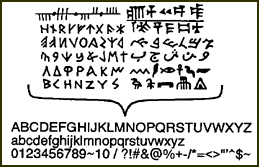
The evolution of the Latin Alphabet.

The evolution of the Latin Alphabet.
1/ By the time the logaoedic format of Ogamic messages made its way into the inland sea of the Mediterranean realm it had been altered by compromising with an ideographical system of communication from the Mesopotamia region of Babylonia known as Cunieform.
2/ Phased out by cursive chirography, Cunieform was restricted
to a repetitions system of "A" shaped wedge markings,
usually impressed on clay tablets and later baked, that were
arranged in a coded picture-graphic pattern which expressed a
thought or a idea.
(Cunieform was essentially a poly-syllabic rendition of Sumerian
consonantal epigraphs which reflected a similarity in style and
layout to Egyptian hieroglyphical logograms - in other words,
Cunieform originated from Sumerian and Egyptian pictographs)
3/ Now the maritime culture of the Phoenicians, together with their aquatic cousins - the seafaring Minoans of Crete and the Etrurian sailors of the Tyrrhenian realm, all applied the phonetic and lineal format of Ogam in their epigraphic messages but "chopped up" the main path line and "rotated" the consonants wherein phonetical vowel symbols were inserted periodically so that more omnificent information could be phonogramically conveyed in less space than other forms of existing alphabetical layouts.
4/ And thus began the "A-lineal" style of polyphonic epigraphs to be adopted by the Aeolian culture of ancient Greece.
5/ Moreover, the identifying symbols of Ogamic "letters" were gradually superceded by important "artistic signs" that were less repetitious and geometrically easier to memorize, for example, as we will learn in the next chapter, certain picture-graphic or "iconic" concepts can be found within many of the letters of the Latin alphabet.